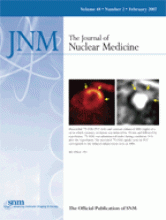REPLY: The correspondents argue that 131I in diagnostic doses has the potential to cause “stunning” of the uptake of the subsequent 131I treatment dose that is given to patients with well-differentiated thyroid carcinomas. We agree that the energy deposited by 131I can injure the function of residual thyroid tissues, benign and malignant. However, the questions are (i) what administered dose of diagnostic 131I is unlikely to produce significant impairment of the subsequent treatment? and (ii) is there a more efficacious method of preliminary evaluation of patients who are candidates for the therapy?
Determination of the absorbed dose of radiation from a given administered dose of 131I is not possible with our current methods. However, from our literature review (1), it seems likely that 1 mCi (37 MBq) will produce modest, if any, impairment of function in the target tissues. In any case, the largest differences between diagnostic and therapeutic images, and in the quantitative measurements made of those images, appear to arise from early effects of the therapeutic dose (1).
The options for pretherapeutic assessments are no thyroid imaging, 123I imaging, or 131I imaging. We agree with Park (2) that not every patient who has had a thyroidectomy for well-differentiated thyroid carcinoma requires therapeutic radioiodine and that a decision for treatment dose will vary with the results of diagnostic scintigraphy.
Although 123I imaging has many virtues, it also exhibits substantial drawbacks. The target-to-background ratio in thyroid scintigraphy is improved by waiting 2 or 3 d after the administration of either radioiodine, thereby permitting the radioiodide in nonthyroid tissues to be excreted; this has been a long-standing principle in scintigraphy of this type. The efficiency of detection of γ-photons is greater for 123I but, at 2 d when 123I has decayed through 3–4 half-lives, the administered dose of 123I must be about 10 mCi (370 MBq) to equal the information obtained from 1 mCi of 131I. Indeed, although there were no differences in accuracy between 0.3 mCi (11.1 MBq) of 123I and 3–10 mCi (111–370 MBq) of 131I in detecting thyroid remnants (tissues that often concentrate 1%–10% of the dose), in reassessments after ablative therapy, when any persisting tissues are less prominent, images made with 131I had an advantage over 123I, 92.5% vs. 69.4% (3).
More important is the application of dosimetry. This type of evaluation aids in determining prescriptions of therapeutic radioiodine when larger doses are thought to be more effective in treatment of health- and life-impairing carcinomas and in avoiding serious toxicity from 131I as reiterated in a recent issue of The Journal of Nuclear Medicine (4). Measurements for dosimetry often require acquisitions of data for up to 4 d, information that is unattainable with any reasonable doses of 123I.
In summary, even small amounts of ionizing radiation have the potential to injure thyroid tissues. However, the advantages of scintigraphy in evaluating patients with thyroid carcinoma generally override a small risk. We believe that images made with 1 mCi of 131I pose a small and acceptable risk. The limitations of 123I, especially in making measurements for dosimetry, are unacceptable, particularly when treating patients with advanced disease who are in the greatest need of an optimum therapeutic dose of 131I.
We regret the omission of reports by Lees et al. (5) and Hilditch et al. (6) in our review of literature (1).
Footnotes
-
COPYRIGHT © 2007 by the Society of Nuclear Medicine, Inc.







